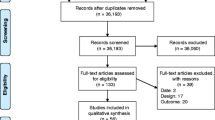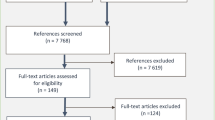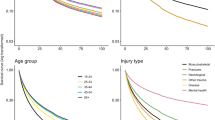Abstract
Purpose Occupational injury and work-related disability is a significant public health problem. For published research to provide a collective knowledge base for return to work (RTW) policy and practice, features of the compensation system relevant to the research must be described clearly. The level of the reporting on compensation system features is yet to be established. The aim of the present study was to synthesize the evidence for the reporting on compensation systems in prognostic studies of RTW following work-related injuries. Methods A systematic review of the literature was conducted. Ovid Medline and EMBASE were searched for studies published 1996–2011. Included studies were prognostic studies of RTW or work disability following work-related acute traumatic injuries. Results The initial search yielded 952 articles; 37 articles fulfilled the inclusion criteria. The majority of studies were based on clinical practice; eight studies were based on administrative data. Only two studies reported seven or more compensation features and two studies reported four to six. The majority of studies (19/37) did not report on any aspect of the compensation system that study participants were interacting with. The most common information reported was the extent of coverage at the population level (7/37) and the availability of wage replacement entitlements (7/37). The name of the compensation system was provided in 5 studies. Conclusions Overall reporting on compensation systems in prognostic studies of RTW needs to be improved if research evidence is to inform policy and practice. Compensation system features that could be reported are provided.

Similar content being viewed by others
References
Anema JR, Schellart AJ, Cassidy JD, Loisel P, Veerman TJ, et al. Can cross country differences in return-to-work after chronic occupational back pain be explained? An exploratory analysis on disability policies in a six country cohort study. J Occup Rehabil. 2009;19:419–26.
OECD. Transforming disability into ability. Polices to promote work and income security for disabled people. OECD; 2003. OECD Code 812003021P1; ISBN: 92-641-988-73.
Urquhart DM, Williamson OD, Gabbe BJ, Cicuttini FM, Cameron PA, et al. Outcomes of patients with orthopaedic trauma admitted to level 1 trauma centres. ANZ J Surg. 2006;76:600–6.
Williamson OD, Gabbe BJ, Cameron PA, Edwards ER, Richardson MD. Predictors of moderate or severe pain 6 months after orthopaedic injury: a prospective cohort study. J Orthop Trauma. 2009;23:139–44.
Vles WJ, Steyerberg EW, Essink-Bot ML, et al. Prevalence and determinants of disabilities and return to work after major trauma. J Trauma. 2005;58:126–35.
Ruseckaite R, Gabbe B, Vogel AP, Collie A. Health care utilisation following hospitalisation for transport-related injury. Injury. 2012;43(9):1600–5.
WorkSafe Victoria statistical summary 2011–2012. Available from http://www.worksafe.vic.gov.au/about-worksafe-victoria/statistics [cited 2013].
Waddell G, Burton A. Is work good for your health and well-being?. London: The Stationery Office; 2006.
Black C. Working for a healthier tomorrow Review of the Health of Britains Working Age Population. TSO London; 2008.
The Australasian Faculty of Occupational and Environmental Medicine Australian and New Zealand Consensus statement. Realising the health benefits of work. The Royal Australian College of Physicians, Sydney. Available from www.racp.edu.au/index.cfm?objectid=5E3445A1-E478-2539 [cited 2012].
Harrison K, Allen S. Features of occupational rehabilitation systems in Australia: a map through the maze. Work. 2003;21(141–52):35.
Higgins JPT, Green S (eds). Cochrane handbook for systematic reviews of interventions version 5.1.0 (updated March 2011). The Cochrane Collaboration, 2011.
Clay FJ, Newstead SV, McClure RJ. A systematic review of early prognostic factors for return to work following acute orthopaedic trauma. Injury. 2010;41:787–803.
Boake C, McCauley SR, Pedroza C, Levin HS, Brown SA, et al. Lost productive work time after mild to moderate traumatic brain injury with and without hospitalization. Neurosurgery. 2005;56:994–1003.
Bruyns CNP, Jaquet J-B, Schreuders TAR, Kalmijn S, Kuypers PDL, et al. Predictors for return to work in patients with median and ulnar nerve injuries. J Hand Surg Am. 2003;28:28–34.
Burnham RS, Warren SA, Saboe LA, Davis LA, Russell GG, et al. Factors predicting employment 1 year after traumatic spine fracture. Spine. 1996;21:1066–71.
Chang J-H, Wu M, Lee C-L, Guo Y-L, Chiu H-Y. Correlation of return to work outcomes and hand impairment measures among workers with traumatic hand injury. J Occup Rehabil. 2011;21:9–16.
Clay FJ, Newstead SV, Watson WL, McClure RJ. Determinants of return to work following non life threatening acute orthopaedic trauma: a prospective cohort study. J Rehab Med. 2010;42:162–9.
Clay FJ, Newstead SV, Watson WL, Ozanne-Smith J, McClure RJ. Bio-psychosocial determinants of time lost from work following non life threatening acute orthopaedic trauma. BMC Musculoskelet Disord. 2010;11:6.
Clay FJ, Newstead SV, D’Elia A, McClure RJ. First return to work following injury: does it reflect a composite or a homogeneous outcome? Occup Environ Med. 2010;67:730–6.
Du C-L, Lai C-F, Wang J-D. Delayed return-to-work in workers after non-severe occupational upper extremity fracture in Taiwan. J Formos Med Assoc. 2007;106:887–93.
Dunn WR, Lincoln AE, Hinton RY, Smith GS, Amoroso PJ. Occupational disability after hospitalization for the treatment of an injury of the anterior cruciate ligament. J Bone Joint Surg Am. 2003;85-A(9):1656–66.
Fan JK, McLeod CB, Koehoorn M. Sociodemographic, clinical, and work characteristics associated with return-to-work outcomes following surgery for work-related knee injury. Scand J Work Environ Health. 2010;36:332–8.
Gross DP, Battie MC. Recovery expectations predict recovery in workers with back pain but not other musculoskeletal conditions. J Spinal Disord Tech. 2010;23:451–6.
He Y, Hu J, Yu I, Gu W, Liang Y. Determinants of return to work after occupational injury. J Occup Rehabil. 2010;20:378–86.
Hebert JS, Ashworth NL. Predictors of return to work following traumatic work-related lower extremity amputation. Disabil Rehabil. 2006;28:613–8.
Hepp U, Moergeli H, Buchi S, Bruchhaus-Steinert H, Sensky T, et al. The long-term prediction of return to work following serious accidental injuries: a follow up study. BMC Psychiatry. 2011;11:53.
Holtslag HR, Post MW, van der Werken C, Lindeman E. Return to work after major trauma. Clin Rehabil. 2007;21:373–83.
Hou W-H, Tsauo J-Y, Lin C-H, Liang H-W, Du C-L. Worker’s compensation and return-to-work following orthopaedic injury to extremities. J Rehabil Med. 2008;40:440–5.
Jaquet J-B, Kalmijn S, Kuypers PDL, Hofman A, Passchier J, et al. Early psychological stress after forearm nerve injuries: a predictor for long-term functional outcome and return to productivity. Ann Plast Surg. 2002;49:82–90.
Jaquet JB, Luijsterburg AJ, Kalmijn S, Kuypers PD, Hofman A, et al. Median, ulnar, and combined median-ulnar nerve injuries: functional outcome and return to productivity. J Trauma. 2001;51:687–92.
Lange C, Burgmer M, Braunheim M, Heuft G. Prospective analysis of factors associated with work reentry in patients with accident-related injuries. J Occup Rehabil. 2007;17:1–10.
Lee Y-Y, Chang J-H, Shieh S-J, Lee Y-C, Kuo L-C, et al. Association between the initial anatomical severity and opportunity of return to work in occupational hand injured patients. J Trauma. 2010;69:E88–93.
MacDermid J, Roth J, McMurtry R. Predictors of time lost from work following a distal radius fracture. J Occup Rehabil. 2007;17:47–62.
MacKenzie EJ, Morris JA Jr, Jurkovich GJ, Yasui Y, Cushing BM, et al. Return to work following injury: the role of economic, social, and job-related factors. Am J Public Health. 1998;88:1630–7.
Mason S, Wardrope J, Turpin G, Rowlands A. Outcomes after injury: a comparison of workplace and nonworkplace injury. J Trauma. 2002;53:98–103.
Meerding WJ, Looman CWN, Essink-Bot M-L, Toet H, Mulder S, et al. Distribution and determinants of health and work status in a comprehensive population of injury patients. J Trauma. 2004;56:150–61.
Murphy GC, Young AE, Brown DJ, King NJ. Explaining labor force status following spinal cord injury: the contribution of psychological variables. J Rehabil Med. 2003;35:276–83.
Murphy G, Brown D, Athanasou J, Foreman P, Young A. Labour force participation and employment among a sample of Australian patients with a spinal cord injury. Spinal Cord. 1997;35:238–44.
Opsteegh L, Reinders-Messelink HA, Schollier D, Groothoff JW, Postema K, et al. Determinants of return to work in patients with hand disorders and hand injuries. J Occup Rehabil. 2009;19:245–55.
Reynolds S, Paniak C, Toller-Lobe G, Nagy J. A longitudinal study of compensation-seeking and return to work in a treated mild traumatic brain injury sample. J Head Trauma Rehabil. 2003;18:139–47.
Richmond TS, Amsterdam JD, Guo W, et al. The effect of post-injury depression on return to pre-injury function: a prospective cohort study. Psychol Med. 2009;39:1709–20.
Rosberg HE, Carlsson KS, Dahlin LB. Prospective study of patients with injuries to the hand and forearm: costs, function, and general health. Scand J Plast Reconstr Surg Hand Surg. 2005;39:360–9.
Rusch MD, Dzwierzynski WW, Sanger JR. Return to work outcomes after work-related hand trauma: the role of causal attributions. J Hand Surg Am. 2003;28:673–7.
Schnyder U, Moergeli H, Klaghofer R. Does patient cognition predict time off from work after life-threatening accidents? Am J Psychiatry. 2003;160:2025–31.
Seland K, Cherry N, Beach J. A study of factors influencing return to work after wrist or ankle fractures. Am J Ind Med. 2006;49:197–203.
Webster BS, Verma S, Willetts J, Hopcia K, Wasiak R. Association of disability duration with physical therapy services provided after meniscal surgery in a workers’ compensation population. Arch Phys Med Rehabil. 2011;92:1542–51.
Wong JYP. Time off work in hand injury patients. J Hand Surg Am. 2008;33:718–25.
Yang Z, Lowe AJ, de la Harpe DE, Richardson MD. Factors that predict poor outcomes in patients with traumatic vertebral body fractures. Injury. 2010;41:226–30.
Young AE, Wasiak R, Webster BS, Shayne RG. Urban-rural differences in work disability after an occupational injury. Scand J Work Environ Health. 2008;34:158–64.
Menard MR. Comparison of disability behavior after different sites and types of injury in a workers’ compensation population. J Occup Environ Med. 1996;38:1161–70.
Jacobs D. Low public expenditure on social welfare: do East Asian countries have a secret? Int J Soc Welfare. 2000;9:2–16.
Gabbe BJ, Cameron PA, Williamson OD, Edwards ER, Graves SE, et al. The relationship between compensable status and long-term patient outcomes following orthopaedic trauma. Med J Aust. 2007;187:14–7.
Harris I, Mulford J, Solomon M, et al. Association between compensation status and outcome after surgery: a metaanalysis. JAMA. 2005;293:1644–52.
International Association of Industrial Accident Boards and commissions. Available from www.iaiabc.com [cited 2012].
SafeWork Australia Comparison of Workers’ Compensation Arrangements in Australia and New Zealand. 2012. Available from www.safeworkaustralia.gov.au/ [cited 2012].
Australian and New Zealand Consensus Statement on the Use of Research Evidence in Compensation Policy and Practice. Available from www.iscrr.com.au/.../Final%20Consensus%20Statement_15%20Feb%... [cited 2012].
Acknowledgments
The authors wish to thank the following key researchers for providing opinion on the reporting on compensation systems in research studies. Genevieve Grant, Robert Guthrie, Rebbecca Lilley, Katherine Lippel, Kevin Purse, Jeanne Sears. The authors acknowledge assistance from Adrian Buzgau and Andrew Palagyi in regards to data storage. All authors receive research funding from the Transport Accident Commission and WorkSafe Victoria. Neither funder had any involvement in the study design; collection, analysis and interpretation of data; the writing of the manuscript and the decision to submit the manuscript for publication.
Conflict of interest
The authors declare that there are no conflicts of interest.
Ethical standards
All human studies included in this review have been approved by the appropriate ethics committee and have therefore been performed in accordance with the ethical standards laid down in the 1964 Declaration of Helsinki and its later amendments.
Author information
Authors and Affiliations
Corresponding author
Appendices
Appendix 1
See Table 6.
Appendix 2
Peer reviewed papers on information interventions for recovery from a work-related injury or prognostic factors for RTW following a work-related soft tissue injury.
-
1.
Burton AK, Waddell G, Tillotson KM, Summerton N. Information and advice to patients with back pain can have a positive effect. A randomized controlled trial of a novel educational booklet in primary care. Spine (Phila Pa 1976). 1999; 24:2484–91.
-
2.
Cherkin DC, Deyo RA, Street JH, Hunt M et al. Pitfalls of patient education. Limited success of a program for back pain in primary care. Spine (Phila Pa 1976). 1996; 21:345–55.
-
3.
Coudeyre E, Tubach F, Rannou F, Baron G et al. Effect of a simple information booklet on pain persistence after an acute episode of low back pain: a non-randomized trial in a primary care setting. PLoS One. 2007; 2:e706.
-
4.
Derebery J, Giang GM, Gatchel RJ, Erickson K, Fogarty TW. Efficacy of a patient-educational booklet for neck-pain patients with workers’ compensation: a randomized controlled trial. Spine (Phila Pa 1976). 2009; 34:206–13.
-
5.
Evans DW, Breen AC, Pincus T, Sim J et al. The effectiveness of a posted information package on the beliefs and behaviour of musculoskeletal practitioners: the UK Chiropractors, Osteopaths, and Musculoskeletal Physiotherapists Low Back Pain Management (COMPLeMENT) randomized trial. Spine (Phila Pa 1976). 2010; 35:858–66.
-
6.
Linton SJ, Nordin E. A 5-year follow-up evaluation of the health and economic consequences of an early cognitive behavioural intervention for back pain: a randomized, controlled trial. Spine (Phila Pa 1976). 2006; 31:853–8.
-
7.
Little P, Roberts L, Blowers H, Garwood J et al. Should we give detailed advice and information booklets to patients with back pain? A randomized controlled factorial trial of a self-management booklet and doctor advice to take exercise for back pain. Spine (Phila Pa 1976). 2001;26(19):2065–72.
-
1.
Kucera KL, Lipscomb HJ, Silverstein B, Cameron W. Predictors of delayed return to work after back injury: A case–control analysis of union carpenters in Washington State. Am J Ind Med. 2009; 52:821–30.
-
2.
Young RA, Benold T, Whitham J, Burge S. Factors influencing work interference in patients with chronic low back pain: a Residency Research Network of Texas (RRNeT) study. J Am Board Fam Med. 2011; 24:503–10.
-
3.
Lindell O, Johansson SE, Strender LE. Predictors of stable return-to-work in non-acute, non-specific spinal pain: low total prior sick-listing, high self-prediction and young age. A two-year prospective cohort study. BMC Fam Pract. 2010 20; 11:53.
-
4.
Alexopoulos EC, Konstantinou EC, Bakoyannis G, Tanagra D, Burdorf A. Risk factors for sickness absence due to low back pain and prognostic factors for return to work in a cohort of shipyard workers. Eur Spine J. 2008; 17:1185–92.
-
5.
Pransky GS, Benjamin KL, Savageau JA, Currivan D, Fletcher K. Outcomes in work-related injuries: a comparison of older and younger workers. Am J Ind Med. 2005; 47:104–12
-
6.
Hogg-Johnson S, Cole DC. Early prognostic factors for duration on temporary total benefits in the first year among workers with compensated occupational soft tissue injuries. Occup Environ Med. 2003; 60:244–53.
-
7.
Mayer T, Gatchel RJ, Evans T. Effect of age on outcomes of tertiary rehabilitation for chronic disabling spinal disorders. Spine (Phila Pa 1976). 2001 15; 26:1378–84.
Rights and permissions
About this article
Cite this article
Clay, F.J., Berecki-Gisolf, J. & Collie, A. How Well Do We Report on Compensation Systems in Studies of Return to Work: A Systematic Review. J Occup Rehabil 24, 111–124 (2014). https://doi.org/10.1007/s10926-013-9435-z
Published:
Issue Date:
DOI: https://doi.org/10.1007/s10926-013-9435-z




